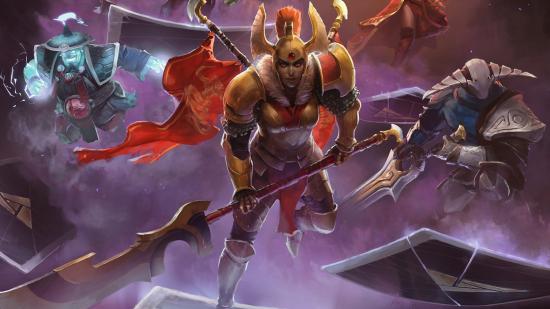Our Verdict
Robust tactics and elegant design ensure Artifact’s often sublime strategy isn’t complex. But a lack of long-term goals and a risky monetisation strategy leaves the game’s future feeling uncertain.
Artifact is a card game too big to live on a single board. Valve spreads the playfield of its digital CCG between three separate lanes and gives you control of five heroes – some pulled directly from Dota, others invented for this spin-off. Buffs and modifiers stack without a cap, mana generates continuously, and your heroes respawn in a non-stop cycle of death and rebirth. Artifact takes full advantage of digital conveniences to help you digest an overwhelming amount of information, and all those details add up to an immensely satisfying game of strategy.
You don’t have direct control over everything you see on the board. You can choose your deck’s five heroes – powerful unit cards with unique abilities – and the colours of those heroes determine which cards you’ll be able to play in which lanes. During deckbuilding, you can also choose three of those five heroes to be deployed first, but they’re distributed between the lanes at random. You can equip your heroes with gear that boosts their capabilities but can only purchase items from a random selection that appears between rounds. Units pick their own targets, but you can spend mana on spells to redirect those attacks.
It’s this push and pull between random elements and your limited resources to influence them that forms the heart of Artifact. Once you and your opponent commit your actions, the units in that lane smash against each other in a single wave of offensive energy. You can always see exactly what will happen when the clash goes down. Doomed heroes will display an ominous red X, and you can hover over their health values to find out exactly where that damage is coming from.
Each round, then, is a process of sculpture. You want the play in every lane to end with the best possible circumstances for you, and the worst for your opponent. So you’ll look at those impending damage values, then play your cards to alter the course of action. Give an expendable creep taunt to draw attacks away from your valuable units, then drop a sword on one of your heroes to grant a killing blow against a pesky enemy and gain an advantage in the lane – whatever gets you closer to winning the encounter.
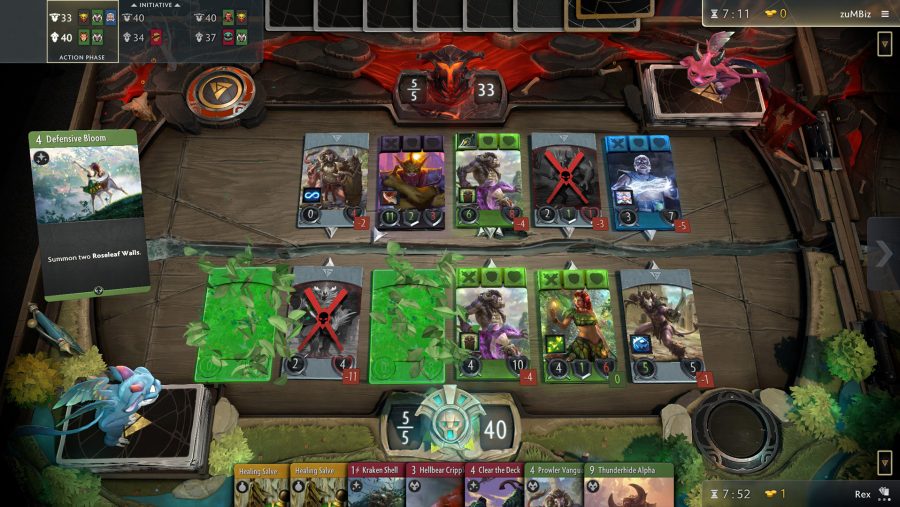
You and your opponent take turns committing actions before you’re either out of resources or ready for the clash to go down. These turns are a resource unto themselves. Whoever passed first in the last lane will get to play first in the next one. A card like Gust allows you to silence enemy heroes for a round – preventing them from using active abilities and stopping your opponent from playing coloured cards. If you can play that on the first turn in a lane, you’ve got complete control there, while the other player is helpless. Or you might want to cede initiative so you can wait out your opponent’s moves, then play a big card once they’re out of resources and can no longer counter it.
You can build improvements in each lane and put buffs on your heroes and creeps. These are usually permanent and they all stack. Play Cheating Death to give every allied unit in a lane a 50% chance of surviving a lethal attack. Play it again and you get to make that coin flip twice. Play it three times and the units in that lane will be all but invincible.
Your ultimate goal is to destroy either two of your opponent’s towers or kill their Ancient. The structures sit at the end of each lane. If you’ve managed to clear a path through your enemy’s pieces then your creeps’ and heroes’ attacks hit the tower on that lane. The Ancient spawns in the rubble of the first building you destroy, and you can focus on killing the creature or on a tower in another lane.
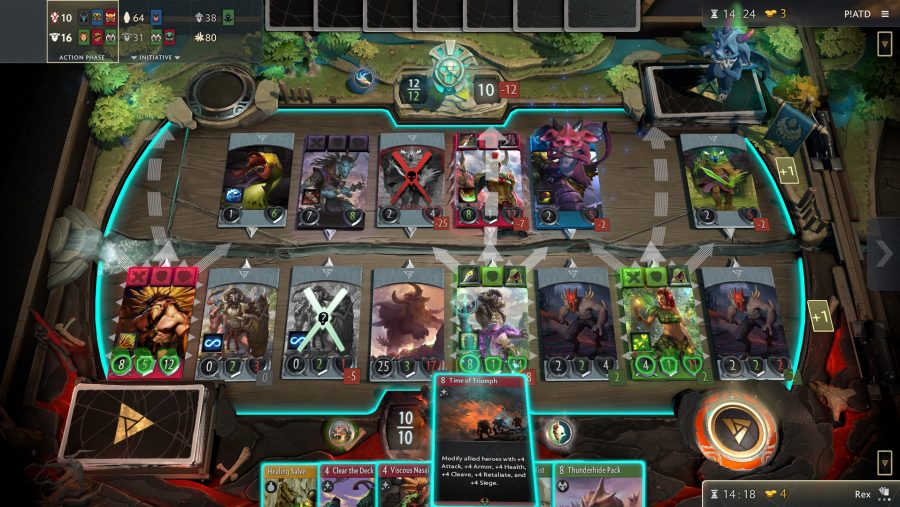
Bramble maze
Artifact matches get very big, very fast. A card like Red Mist Pillager creates a copy of itself every time you do damage to an opponent’s tower, and those kinds of cards can quickly spiral out of control – it’s not unusual to see upwards of a dozen cards in each lane. That spirit of largeness carries through everything in Artifact. There’s no limit to how many units or improvements can be in a lane. No limit to how many times you can buff a hero. No caps on your mana growth, and no limit on the cards you can keep in your hand. Battles just keep expanding until one side out-powers the other.
Heroes are the key reason for that power curve. When your opponent kills one of your heroes they get a bounty in gold. Your hero isn’t gone permanently but is sent to the Fountain where it spends a round out of play. All the equipment on those heroes and all the permanent buffs you’ve applied stay even after death, so your warriors just keep growing in power. You usually want to protect your heroes so you can keep their abilities in play and keep your opponent from collecting the bounty, but sometimes it’s better to let them die, allowing you the chance to get them into a lane where they’ll be more useful.
Action in each lane is pretty much independent, but there are plenty of decisions that affect every part of the board. Each lane’s mana pool is independent, but you’re playing spells from the same hand everywhere. Certain spells can deal damage to units in whichever lane you want. Most importantly, you have to smartly distribute your heroes between the lanes to keep competitive. Lanes become a sort of rock-paper-scissors game with a massive web of interlocking resources to manage as you figure out where you’re strongest and where your opponent is weakest.
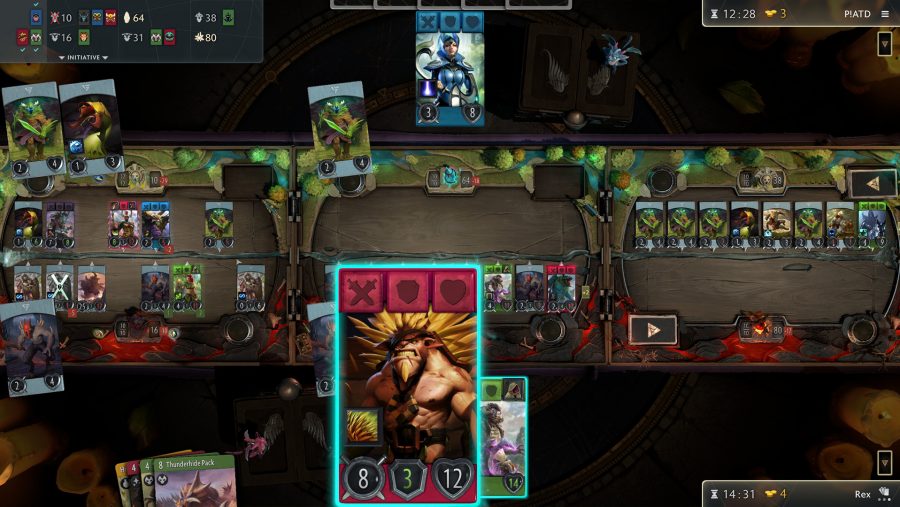
All this is to say that Artifact is a staggeringly complex game that offers strategic possibilities at every turn. But information on all its various parts is easy to access and simple to understand. You can see breakdowns of every buff, debuff, and damage value on the board by just hovering over a given unit, and you can double click any card to see a full breakdown of its abilities, along with further simple explanations of any keywords it references.
The built-in tutorial explains most of the basic mechanics quickly and clearly – though it skimps on some important details, leaving you to check a how to play guide for things such as how attack direction is chosen – and it’s easy enough to understand the essentials after just a couple of matches. You can get into bot matches with a variety of AI difficulty levels and have the option to disable turn timers in those battles, giving you a perfect opportunity to practise your skills.
Once you’ve graduated from bot matches you’ll want to play against human opponents online. You have the expected options to play against friends, or you can get into matchmaking with constructed decks and go for gauntlet wins in either draft or constructed play.
If you’re not interested in paying extra money to collect new cards then Casual Phantom Draft will likely be your main Artifact mode. Here, you take turns selecting 60 cards from a typical distribution of card packs, then you build a deck out of your selections and try for your best results online. This mode gives you a chance to play with every card in the base set, and the limitations around your card selections mean that each run against online players in the gauntlet could be wildly different from the last.
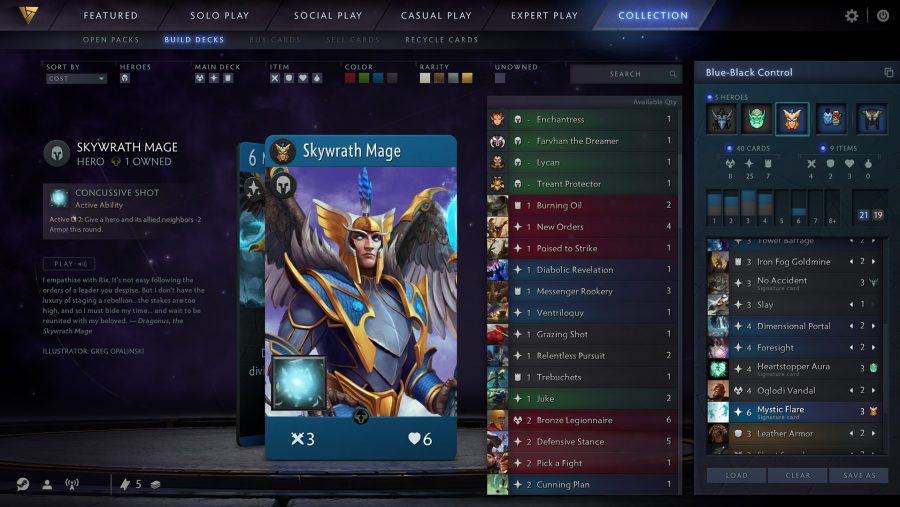
Not-so secret shop
Whether you’re building constructed decks or throwing cards together in draft mode, the deck builder is a joy to use. It lays out all the basic requirements in your deck in simple terms, turning little warning lamps from red to blue as you satisfy those needs. You can see your deck’s mana curve broken down with how many cards you have at each level, and how many of each colour. You can even see counts for specific card types broken down in each category, so you know at every turn where your deck is trending. A little deck code can be conveniently plugged into any browser so you can share your builds online. They’re all smart features that let you focus on the actual strategy of deckbuilding rather than getting caught up in messy interface limitations.
Building decks means gathering more cards, and – here’s a little warning – this is where talking about the game gets strange. Artifact costs money, unlike the free-to-play model adopted by nearly every other digital CCG out there. The idea is that your cards will have real-world value, just like the physical cards you’d have in a game like Magic: The Gathering. The purchase price gets you the equivalent of a starter set with a couple of preconstructed decks and ten card packs. You can sell cards on the Steam Market and use that money to buy the cards you want – or any item of your choice from the Steam Store, if you prefer.
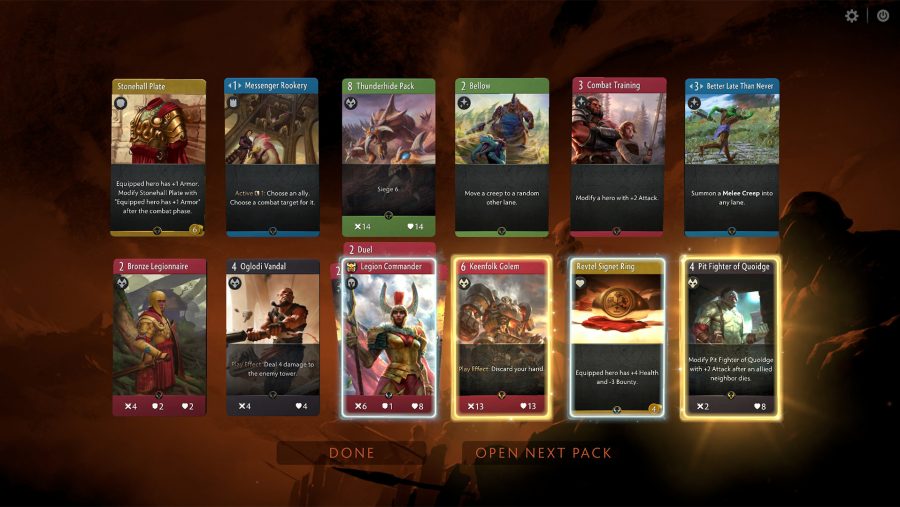
As fabulous a game of strategy as Artifact is, it’s also a wild experiment in monetisation and digital economics, and it’s impossible to disentangle those two elements of the game’s design. We haven’t seen Market integration pre-release, and it’ll likely be weeks and months before everyone has figured out the economics and determined exactly what the value of these cards will be.
In theory, with every card available for direct purchase, it’ll be much easier and somewhat cheaper to build a competitive deck than in most digital CCGs, where you have to grind out various currencies to get the specific cards you want. The cards from the starting packs alone should trade well to help you build an effective deck at little additional cost. It’s much more akin to a real trading card game in that sense, except that when you elect to sell your old collection, you can only cash out in Steam Wallet balance – and, naturally, Valve will take a cut of every transaction.
Whether this strategy of making the cards have value is good or bad is a question that can only be answered over the life of the game, but it’s such an unusual factor that it’s impossible to talk about Artifact without considering the economics. That’s frustrating, but may ultimately be for the best when it comes to getting cards and building effective decks. The prognosis is much less rosy, however, when it comes to the game’s competitive modes and progression systems.
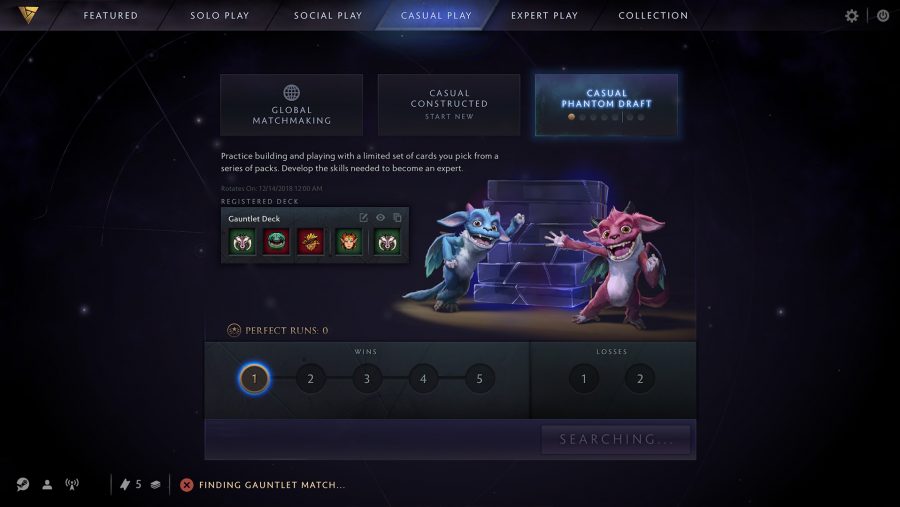
Stick to the jungle
Artifact’s competitive modes – labeled ‘expert play’ in the client – are your only path to earn more card packs in-game, and they all cost Event Tickets to enter. You get five tickets with Artifact and you can buy more at $1 USD (£0.78) each. One ticket will get you into Expert Constructed or Phantom Draft, gauntlet modes which challenge you to rack up five wins before suffering two losses.
Three wins get you back your Event Ticket, four wins get you a card pack, and five wins get you two card packs. Playing these modes – essentially gambling a real dollar against your skills – is the only way to earn more cards in-game. If you’re out of tickets, you’ll have to pony up real cash or break down cards out of your collection for more.
Those paid modes are the only places where your victories will get you anything. Artifact launches without any long-term progression systems – no daily quests, no visible MMR, and no competitive rankings. There is skill-based matchmaking, but it’s an invisible process that doesn’t surface information to you. Valve says progression is “top of the list” for new features post-launch, but for now, once you’ve had your fun with the free constructed and draft modes it’s tough to shake the feeling that your wins and losses don’t mean much.
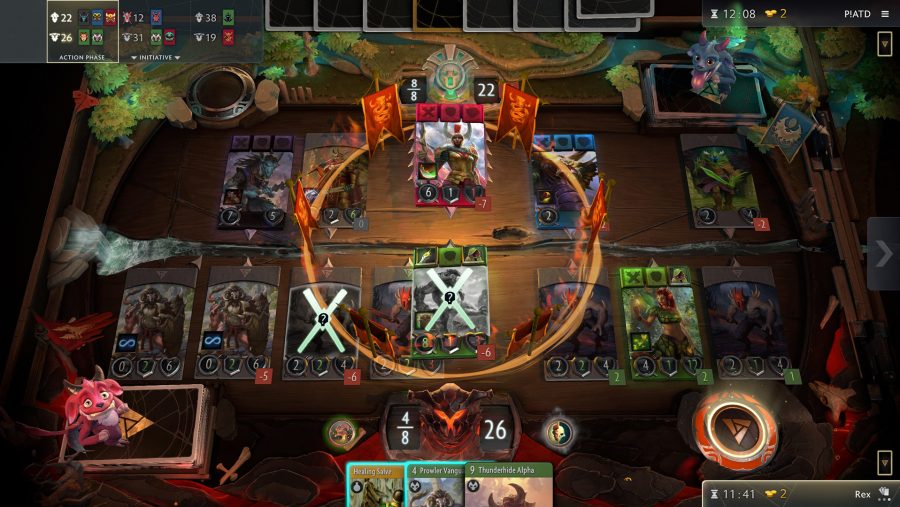
If you don’t want to pump money into Event Tickets, your long-term enjoyment of Artifact will depend on how many of your friends are playing, and how deep you get into community events and tournaments. Tournaments are perhaps Artifact’s most robust play mode, supporting anywhere from four to 128 players in various bracket types, allowing you to test your skills in both constructed and draft modes with a variety of restrictions. That’s a great set of features, but it currently falls entirely on players to host the events and make the rankings that will facilitate the growth of a community.
That uncertainty is the one element holding Artifact back. Your initial purchase gets you quite a bit, including a free draft mode that lets you play and compete with every card in the game, and the excellent strategic core is worth returning to on its own merits. But is that enough to keep you coming back in the weeks and months to come, as new expansions arrive and a meta begins to build around specific cards that’ll rise in price on a user market? Artifact is fabulous in the here and now, certainly, but its future remains uncertain.
